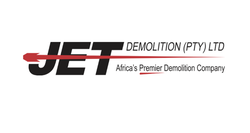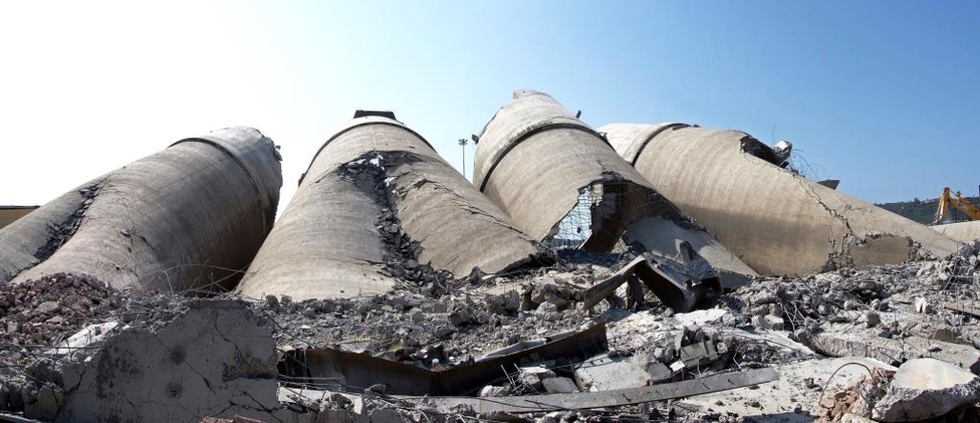Jet Demolition hones its controlled implosion and precision blasting skills
| Jet Demolition hones its controlled implosion and precision blasting skills_approved | 46 KB | Download | |
| Charging of blastholes. | 8.51 MB | Download | |
| Controlled implosion of redundant cooling towers. | 2.33 MB | Download | |
| Explosive demolition of a redundant gasholder. | 4.99 MB | Download | |
| Explosive toppling of the tsunami-damaged Taman Sari Water Tower in Indonesia. | 676.89 KB | Download | |
| The WDA-Award winning Implosion of the HG de Witt building in Pretoria in 2017. | 389.16 KB | Download | |
| Jet Demolition Director Joe Brinkmann. | 3.42 MB | Download |
Controlled implosions generally refer to the precision blasting of a structure, with the intention of having it collapse in and upon itself. Precision blasting, while a function of controlled implosions, may also refer to the strategic placement and timing of detonators to ensure a directional drop biased in a specific direction or sequence, not necessarily within its own footprint.
Both terms refer to placement of charges and execution of the blast in such a manner so as to minimise any secondary damage to nearby structures. Precision blasting also refers to jobs where sectional blasting is required, such as in dam walls, where it is often necessary to remove a section of the wall without damaging the rest of the structure.
Implosions and precision blasting both require extensive preparation, and careful planning and design by the blasting engineer. It is a common misnomer that an implosion is over within a few seconds after the push of a button. Major structures often require months of preparation prior to the blast, and for clean-up operations afterwards.
Implosions and precision blasting can essentially be applied to a multitude of structures, but it is rarely applied, as there are advanced mechanical methods available that are usually quicker and less disruptive to execute. Jet Demolition has applied precision blasting and implosions to high-rise structures (both concrete and steel), redundant gas holders, concrete and steel bridges, and ships and vessels, etc.
“Advances in mechanical demolition technology now mean that we are able to safely demolish complicated structures within very confined spaces, as opposed to blasting, which will inevitably require a large exclusion zone leading up to the blast itself,” Jet Demolition Contracts Manager Kate Bester (N. Dip. Civil Engineering) explains.
A flagship implosion project was the 14-storey HG de Witt Building in Pretoria, which earned Jet Demolition the Explosive Demolition Award at the 2017 World Demolition Awards. The project called for extensive, out-of-the-box thinking, with new techniques developed to ensure the safe execution of the works.
“This project is a prime example of the precision required to execute an implosion well, as the building was situated within a very busy city centre, with a heritage structure mere meters away,” Bester notes.
Elsewhere, Jet Demolition also carried out the explosive demolition of the 44-m-high Taman Sari Water Tower damaged in the 2004 tsunami in Banda Aceh, Indonesia for the United Nations Development Programme. “Although we are requested to undertake explosive demolition works abroad, it is usually quicker, and more affordable, to offer clients a mechanical approach instead,” Bester stresses.
Jet Demolition Director Joe Brinkmann (Pr. Eng.) is the company’s blasting engineer, and designs the vast majority of the methods and strategies required for its explosive demolition projects. As precision blasting and implosions are few and far between, Brinkmann often reaches out to a network of experienced blasting professionals across the world, ensuring that the technique and approach decided upon is the optimal approach for the project. Similarly, he assists other professionals when faced with challenging projects, embracing the concept of a global community.
Hybrid methodologies have been devised, based on the technical and on-site conditions and constraints. Most commonly, a thorough understanding of the as-built structure is required, as well as its condition and history. Once a structure has been exposed to unforeseen external factors, such as a fire within a building or a severe earthquake, the integrity and behaviour of the structure changes.
Other factors include proximity to other structures, subsurface conditions and services, vibration criteria, the direction and impact of fall, the timing of the project, and how the structure is anticipated to react. “There is no ‘one-stop’ solution that can predict exactly how a structure will react, but advances in modelling and a lifetime of experience enhance the probability of a technically-challenging project going to plan,” Brinkmann highlights.
The health and safety risks for implosions and precision blasting projects are very much in line with any regular demolition project. However, the main differences include the possibility of a much greater degree of interaction with the general public.
This includes the evacuation of common spaces, evacuation of neighbouring buildings, and the closing off of streets within the exclusion zone, etc. During the preparatory phases, more often than not, detailed dilapidation studies are carried out to monitor neighbouring structures’ reaction to the blast.
Jet Demolition has over 30 years’ experience in applied research and development of explosive blasting and controlled implosion techniques for large and heavy industrials applications. Its in-house blasting designs and project execution using its range of specialised charges ensures reliable results under the most demanding of conditions. All controlled implosions and precision blasting projects adhere to all legislative and regulatory requirements, and are fully managed by a certified and experienced explosives engineer.
“Every demolition project brings with it innovation and forward-thinking. Advances in the explosive and implosive fields are being made with just about any large project undertaken, as the strategy and method is adapted to suit the specific requirements of the project at hand. Currently, there is a large focus on modelling software that could help to project a structures’ reaction, but nothing will replace experience wholly,” Brinkmann concludes.
Ends
Connect with Jet Demolition on Social Media to receive the company’s latest news
Facebook: https://www.facebook.com/JetDemolition/?ref=br_rs
LinkedIn: https://www.linkedin.com/company/jet-demolition-pty-ltd/
Notes to the Editor
To download hi-res images for this release, please visit http://media.ngage.co.za and click the Jet Demolition link to view the company’s press office.
About Jet Demolition
Jet Demolition has been undertaking industrial demolition works since 1994, and is the leading, largest, and most technically-advanced demolition company in Africa. It offers in-house, full-range demolition services, including advanced mechanical solutions and controlled implosions. It actively pursues ongoing development of skills and equipment suited to the changing needs of the industry.
Jet Demolition is a technically-based company, with various staff members holding MSc, BSc, and BTech Degrees, as well as National Diplomas, in various engineering fields. This expertise gives it the technical foundation to successfully engineer solutions for large and complex demolition projects, and furthermore fuels its drive to deliver quality projects safely. Jet Demolition strives to offer its clients innovative and technical solutions to demanding demolition challenges.
Jet Demolition Contact
Kate Bester (NDip Civil Engineering)
Contracts Manager
Phone: (011) 495 3800
Cell: 072 811 5310
Email: kate [at] jetdemolition [dot] co [dot] za
Media Contact
Renay Tandy
NGAGE Public Relations
Phone: (011) 867 7763
Fax: 086 512 3352
Cell: 082 562 5088
Email: renay [at] ngage [dot] co [dot] za
Web: www.ngage.co.za
Browse the NGAGE Media Zone for more client press releases and photographs at http://media.ngage.co.za

